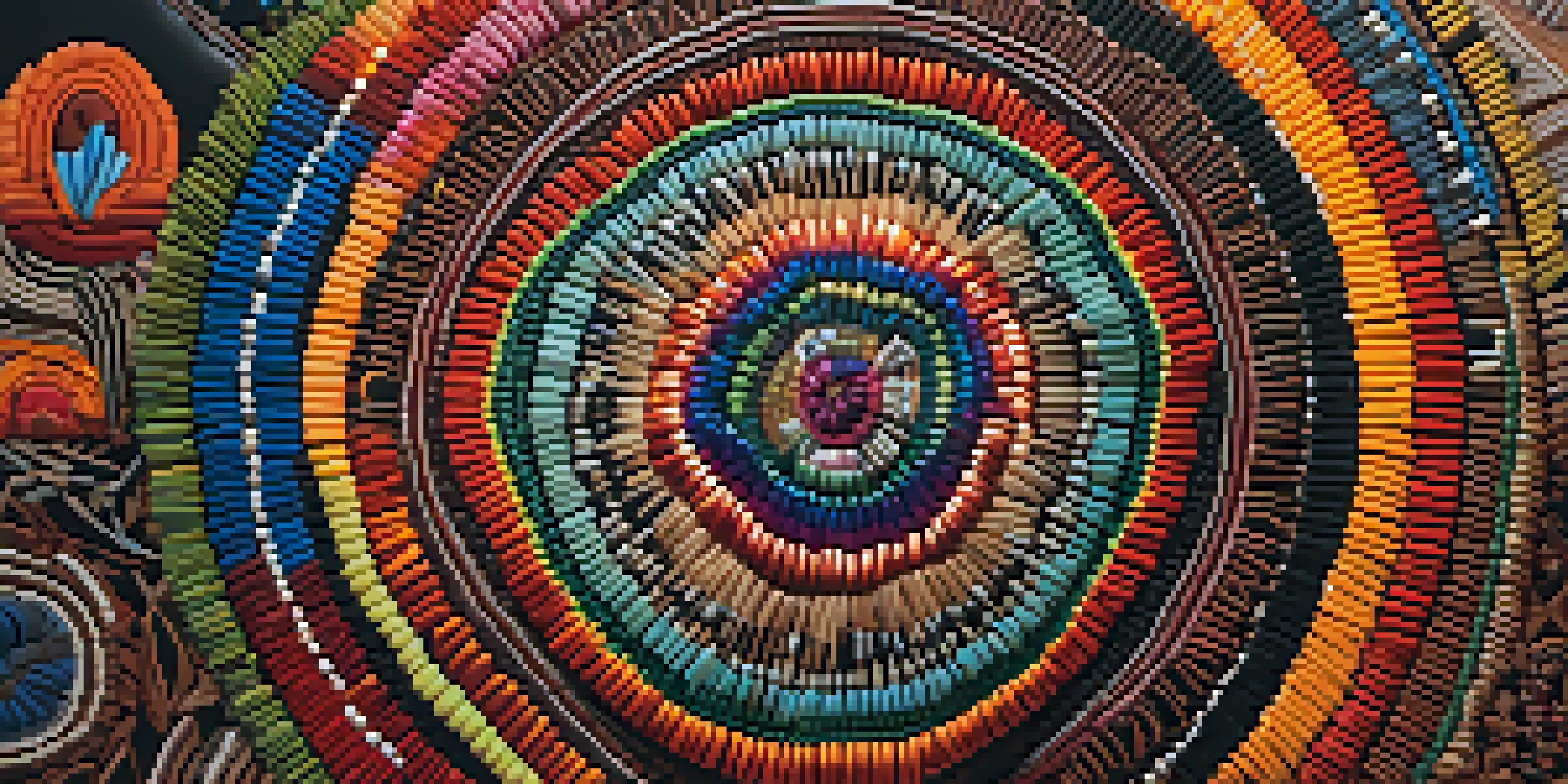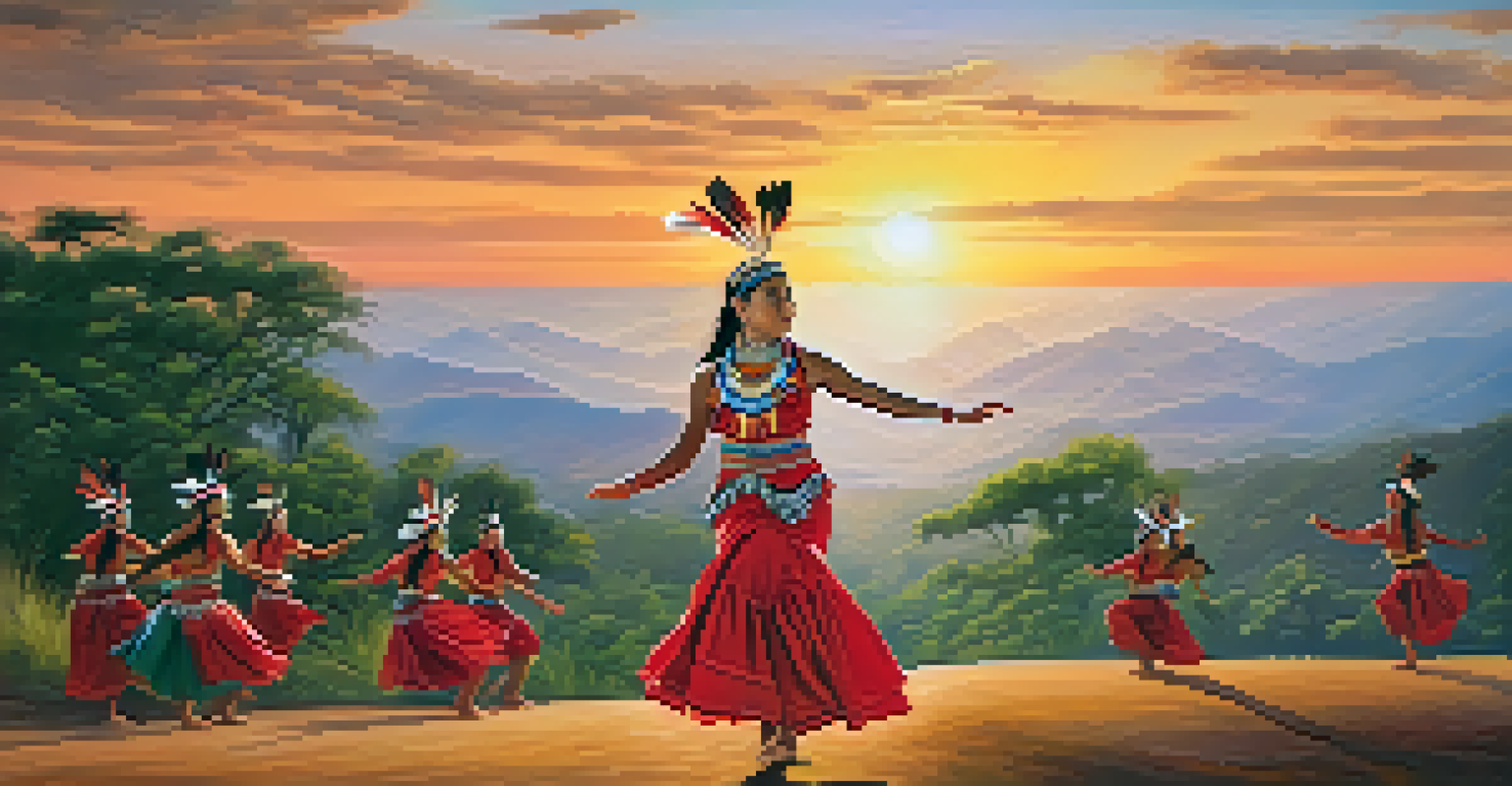The Role of Art in Preserving Indigenous Cultural Memories

Understanding Indigenous Cultural Memories
Indigenous cultural memories encompass the stories, traditions, and practices that shape a community's identity. These memories are often passed down through generations, serving as a vital link to ancestral knowledge and heritage. Art plays a crucial role in this preservation, acting as a vessel for conveying these cultural narratives.
Indigenous art is not just a form of expression; it is a vessel of memory, a means to carry our stories through time.
Whether through storytelling, dance, or visual art, Indigenous peoples have utilized various forms of artistic expression to keep their histories alive. Each piece of art tells a story, capturing the essence of a culture and its values. This storytelling aspect is not just about aesthetics; it’s about sustaining a community’s legacy.
As modern society evolves, the need to preserve these cultural memories becomes increasingly important. Art offers a way to maintain these connections, ensuring that the richness of Indigenous cultures is not lost to time.
The Power of Visual Arts in Cultural Expression
Visual arts, such as painting and sculpture, are powerful tools for expressing Indigenous identity. Artists often draw inspiration from their surroundings, using colors, symbols, and motifs that resonate deeply with their cultural history. This form of art is not just decorative; it embodies historical events, spiritual beliefs, and communal values.

Take, for example, the intricate beadwork and weaving traditions of many Indigenous communities. Each pattern and design holds significant meanings, reflecting stories and teachings that have been passed down through generations. These visual expressions become a means of dialogue between the past and present, enriching cultural understanding.
Art Preserves Indigenous Culture
Indigenous art forms, such as storytelling, visual arts, and performance, play a crucial role in preserving cultural memories and connecting communities to their heritage.
Moreover, visual art serves as a platform for advocacy, allowing Indigenous artists to raise awareness about social issues affecting their communities. By sharing their stories through art, they can bridge gaps between cultures and promote respect for Indigenous heritage.
Performance Arts as Living History
Performance arts, including dance and theater, are dynamic ways to keep Indigenous cultural memories alive. These art forms often involve participation from community members, creating a shared experience that enhances cultural bonds. Through performance, traditional stories and rituals are reenacted, allowing audiences to engage with their heritage actively.
Art is a powerful way to connect people and cultures, making the invisible visible and the unheard heard.
For instance, many Indigenous ceremonies incorporate dance as a way to honor ancestors and celebrate life's milestones. These performances are not merely entertainment; they are sacred acts that reinforce communal identity and continuity. Audiences witness the living history of their culture unfolding before their eyes.
As these art forms evolve, they can also incorporate contemporary themes, making them relevant in today's world. This blend of tradition and modernity helps attract younger generations, ensuring that cultural memories remain vibrant and accessible.
Literature's Role in Documenting Oral Traditions
Literature, particularly poetry and storytelling, plays a significant role in documenting Indigenous oral traditions. Many Indigenous cultures have rich oral histories that convey wisdom, morals, and cultural values. By writing down these stories, authors help preserve them for future generations and provide broader access to their teachings.
For example, many Indigenous writers draw upon their lived experiences and cultural narratives to create powerful literary works. These stories not only entertain but also educate readers about the intricacies of Indigenous life and perspectives. In this way, literature serves as both a preservation tool and a means of cultural exchange.
Digital Art Expands Cultural Reach
In the digital age, Indigenous artists leverage technology and social media to share their cultural narratives, fostering global connections and engaging younger generations.
In addition, the growing appreciation for Indigenous literature in mainstream circles helps raise awareness and foster empathy. Through the written word, non-Indigenous readers can gain insight into the beauty and complexity of Indigenous cultures, further promoting respect and understanding.
Digital Art: Bridging Generations and Cultures
In today's digital age, technology has opened new avenues for Indigenous artists to share their cultural memories. Digital art, including graphic design and multimedia projects, allows for innovative expressions that can reach a global audience. This form of art provides a platform for younger generations to engage with their heritage in ways that resonate with their experiences.
Moreover, social media has become a powerful tool for Indigenous artists to showcase their work and foster community connections. Through platforms like Instagram and TikTok, artists can share their stories, techniques, and cultural significance with a wider audience, encouraging appreciation and dialogue.
By embracing digital art forms, Indigenous communities can reclaim their narratives in the face of historical misrepresentation. This modern approach to cultural preservation ensures that Indigenous voices are heard and celebrated, bridging the gap between tradition and contemporary life.
Art as a Form of Resistance and Empowerment
Art has long been a form of resistance for Indigenous peoples, serving as a means to challenge stereotypes and assert cultural pride. Through their work, artists can confront historical injustices and advocate for their communities, fostering a sense of empowerment. This artistic expression becomes a tool for social change, raising awareness about the challenges Indigenous people face today.
For example, many contemporary Indigenous artists address issues like land rights, environmental concerns, and cultural appropriation in their work. By tackling these subjects, they not only educate the public but also inspire action within their communities. Art, in this sense, becomes a powerful voice for the voiceless.
Art as Resistance and Empowerment
Art serves as a powerful form of resistance for Indigenous peoples, enabling them to challenge stereotypes, advocate for their rights, and promote healing within their communities.
Additionally, the act of creating art can be therapeutic, allowing individuals to process their experiences and emotions. This healing aspect of art can strengthen community bonds and promote resilience, reinforcing the importance of cultural memory in overcoming adversity.
Collaborative Efforts in Cultural Preservation
Collaboration between Indigenous artists and non-Indigenous communities is vital for cultural preservation. These partnerships can foster understanding and respect, allowing for shared learning experiences. They also help amplify Indigenous voices, ensuring that cultural memories are represented authentically.
For instance, art exhibitions that showcase Indigenous artists can create opportunities for dialogue and cultural exchange. By inviting non-Indigenous audiences to engage with Indigenous art, these initiatives promote appreciation and awareness of the complexities of Indigenous cultures.

Moreover, educational programs that involve Indigenous art forms can empower younger generations to embrace their heritage. By learning from Indigenous artists, students can gain a deeper understanding of cultural significance while appreciating the beauty and diversity of Indigenous expressions.